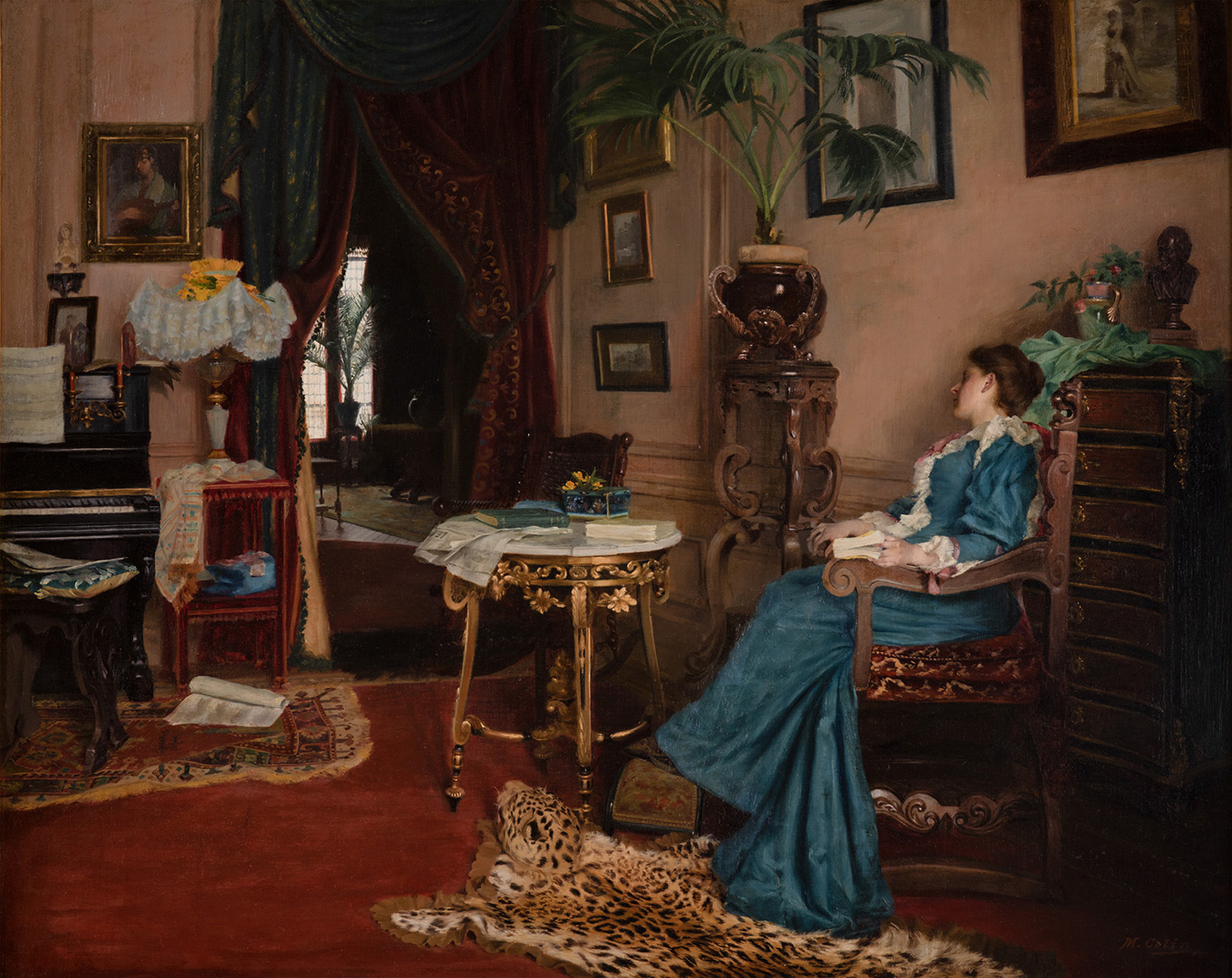One Thousand and One Nights is the story of Scheherazade who, threatened with death by King Shahryar, keeps herself alive by telling one fascinating tale after another, stopping at a cliffhanger each night so the king would want to hear the rest. Her resolve and wit, as well as her beauty, were celebrated in literature and the visual arts, especially in the late 19th century.
This exhibition, focusing on the Gilded Age (1870s–early 1900s), brings together imagined women such as Scheherazade — often represented as an Orientalist fantasy — and real women of the time who, imbued with quiet dignity, contrast greatly with such inventions. Powerful Scheherazade in particular, who makes her appearance in a painting by Wilhelm Vita, is an appropriate icon for the “new” women who began to make their presence felt at the turn of the 20th century.
Influential like Scheherazade, though typically portrayed as immoral, is the Biblical figure Salome, often represented as a seductress. Her dance before King Herod led him to grant her any request. Prompted by her vindictive mother, Salome asked for the head of John the Baptist on a silver platter. An 1890 painting by Ella Ferris Pell represents the beautiful Salome in the aftermath. Balancing the now-empty tray on her knee, she stands resolute. The artist exhibited the work in Paris, where it gained little notoriety, perhaps because this self-confident woman did not fit the predominant Academic depictions of Salome as a depraved temptress. By subverting the narrative of fin-desiècle decadence, Pell set her portrayal apart from those by men, imbuing her Salome with feminist strength.

Ella Ferris Pell, Salome, 1890. Oil on canvas, 52 x 34 in. Collection of Sandra and Bram Dijkstra.

Maximilien Colin, Souvenirs, 1891. Oil on canvas, 29 x 36 1/3 in. Collection of Sandra and Bram Dijkstra.

Robert McGregor, Till Eve Again Recalls Them Loaded Home, circa 1891. Oil on canvas, 24 x 36 in. Collection of Sandra and Bram Dijkstra.
A year later, Maximilien Colin, American like Pell but born in Prussia, created a peaceful domestic scene with a subtly subversive message. Titled Souvenirs, the painting shows a middle-aged woman of some wealth and comfort in her music room, surrounded by palms, a piano, and luxurious rugs. Having paused in her reading, she gazes blankly in reverie, her thoughts turned inward. But the scarves bunched on the furniture, the displaced Oriental carpet, the newspapers and sheet music tossed casually about create a sense of disorder and show the young matron caring little about her surroundings. The scene becomes a depiction of the ennui that accompanied her social position, in which women, while adorning a wealthy home, were often alienated and lonely.
Other women had little time for such
thoughts. Robert McGregor’s
Till Eve Again Recalls Them Loaded Home depicts the
evening routine of bringing cattle back for
milking. The mother who accompanies the
cow to the barn, with two children in tow,
directs not only her household but also many
duties on the farm. Though it seems her life
is one of constant labor, the artist creates an
atmosphere of serenity and modest humanity. The gentle twilight glow contributes to the
beauty of the scene.
The varied roles desired for — and by — women in the Gilded Age, from enchantress to independent worker, to wife and mother, reflect an often-felt conflict between their desires and the limits placed on them by society. Whether ideal or real, the women depicted in the paintings in the Dijkstra collection provide beautiful and fascinating insights into an era and the cultures that produced them.
Scheherazade and her Sisters is scheduled to open on June 21, 2020 and close on September 20, 2020. Dates subject to change.
Top Image: Wilhelm Vita, Scheherazade, ca. 1891. Oil on canvas, 74 x 114 in. Collection of Sandra and Bram Dijkstra.
About the Author: Trained at the National Gallery of Art, the Metropolitan Museum of Art, and the Philadelphia Museum of Art, Crocker Art Museum Curator William Breazeale is the organizer of many exhibitions including The Language of the Nude: Four Centuries of Drawing the Human Body, A Pioneering Collection:Master Drawings from the Crocker Art Museum, and Reuniting the Masters: European Drawings from West Coast Collections.With a Ph.D. from the University of Maryland and a dissertation on Italian sketchbooks, he is the author of articles for Master Drawings including "Old Masters in Old California:the Origins of the Drawings Collection at the Crocker Art Museum," "Nature and a new drawing by Otto Marseus van Schrieck," and "Two Small Heads by Giulio Romano in the collection of the Crocker Art Museum."In addition to coordinating major exhibition catalogues, he has organized exhibitions on Italian paintings and European and American prints for the Crocker, as well as serving as coordinating curator for many loan exhibitions hosted at the Museum, including 2015's The Age of Albrecht Dürer: German Drawings from the École des Beaux-Arts, Paris.


